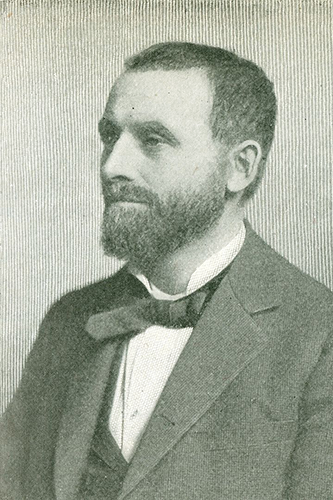

The story behind the construction of Altgeld Hall reflects some of U of I’s most rooted principles. Currently home to the Department of Mathematics, and with previous lives as the university library, administration building, and College of Law, the campus icon is marking the 125th anniversary of its groundbreaking on June 10, 1896.
The need for Altgeld Hall arose from a growing demand for books and study spaces in the 1890s. Students and faculty were insisting on a new library, as the University Hall Library had become overcrowded during a period of rapid expansion on campus. It was no easy journey to construct the new building, however.
Fortunately for campus, the governor of Illinois at the time was John Peter Altgeld, the son of German immigrants who brought him to America when he was three months old. A strong supporter of university education, and a powerful orator, Altgeld believed that a thriving state school could improve the overall quality of life in Illinois.

“[Altgeld] wanted all the boys and girls of the state to have the same educational opportunities as the children of the wealthy,” wrote former U of I President Andrew Draper, who served when Altgeld was governor, in a memoir recounted by Muriel Scheinman (MA, '69; PhD, '81; art history), who wrote extensively about campus history. “He believed that a tax supported university developed up to the plane of the other universities would not only do much for many deserving students who would otherwise not have their opportunity, but also much for the common thinking, for the ordinary industries, for the other institutions of the state, and for the administration of the state itself.”
Draper’s warm comments were written years after the construction of Altgeld Hall. At the time of Governor Altgeld’s administration, however, university administrators were at first cautious about his support for higher education.
“(Governor Altgeld) wanted more buildings, more teachers, more students, more carrying of liberal learning to all the people and all of the interests of the state, and much more money to do things with,” Draper wrote. “It was a little surprising to hear a live governor talk like that but there was nothing in it to dishearten me.”
Their concerns soon abated as Altgeld, a Democrat, upheld promises to push university budget appropriations through the state legislature. That included a frantic episode where the $150,000 required to construct the building was in danger of being eliminated in the Illinois House.
University administrators learned late one night of a pivotal subcommittee meeting the following day where the future building’s fate would be decided, so they undertook a muddy journey by horse overnight to Springfield, arriving there at dawn. Altgeld saw them at his home despite the early hour.
“(Altgeld) said, ‘You attend to the Republicans. Pay no attention to the Democrats, and I will see that every one of them is in the committee and votes for whatever you want,’” Draper recalled. The funding passed 17-6. The Republicans divided, but the solid Democratic vote carried the funding for the future Altgeld Hall.
With funding secured, the university moved forward full-steam with design and construction. The university’s Department of Architecture was tasked with designing the new building. Nathan C. Ricker, head of the department, along with James McLaren White, Newton A. Wells, and a team of students and graduates, completed the work.
They decided on a Romanesque design, with the plans influenced by several famous architectural feats from all over the world, from the Berlin Royal Polytechnikum and St. Mark’s Cathedral in Venice to the Albany (New York) City Hall. The team wanted a building that was permanent and artistic, and that would be different from the other buildings on campus.
Many, including Governor Altgeld, also wanted a building that would represent the lasting ideals of the university. This was eventually reflected in part in the building’s solid, castle-like appearance. Designer Wells stated that the decorations were meant to create an atmosphere of historical association, “so that those entering these halls should feel that the spirit of the mighty past was brooding here and inspiring to the emulation of its noblest achievement.”
Due to political circumstances the building was not named after Altgeld until around 40 years after the former governor’s death in 1902, when he died of a cerebral hemorrhage during a speech. Altgeld Hall became symbolic for the former governor’s outlook on education itself, however.
“(Altgeld) stood by the University of Illinois in the hour of her first great growth and of her imperative need: he exerted the powers of his great office in her behalf to the very limits; and while all the friends of that university, now grown great, may dissent with some of his opinions, no one of them is at liberty to speak unkindly of him,” wrote Draper.
Altgeld Hall opened in 1897. It was added to the National Registry of Historic Buildings in 1970. Learn more about the upcoming renovation of Altgeld Hall and its history at the Altgeld and Illini Hall Project website.


